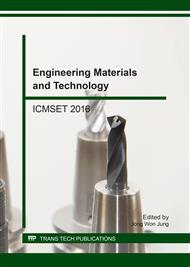[1]
B. L. Zhang, H. Q. Zhang, Y. C. You, Z. J. Du, P. Y. Ding, T. Wang, J. F. Huang, Application of a series of novel chain‐extended ureas as latent‐curing agents and toughening modifiers for epoxy resin, J. Appl. Polym. Sci. 69 (1998) 339-347.
DOI: 10.1002/(sici)1097-4628(19980711)69:2<339::aid-app15>3.0.co;2-r
Google Scholar
[2]
M. Sponton, L. A. Mercado, J. C. Ronda, M. Galia, V. Cadiz, Preparation, thermal properties and flame retardancy of phosphorus-and silicon-containing epoxy resins, Polym. Degrad. Stab. 93 (2008) (2025).
DOI: 10.1016/j.polymdegradstab.2008.02.014
Google Scholar
[3]
M. D. Shau, T. S. Wang, Syntheses, structure, reactivity, and thermal properties of new cyclic phosphine oxide epoxy resins cured by diamines, J. Polym. Sci. Part A: Polym. Chem. 34 (1996) 387.
DOI: 10.1002/(sici)1099-0518(199602)34:3<387::aid-pola7>3.0.co;2-r
Google Scholar
[4]
Y. S. Chiu, Y. L. Liu, W. L. Wei, W. Y. Chen, Using diethylphosphites as thermally latent curing agents for epoxy compounds, J. Polym. Sci. Part A: Polym. Chem. 41 (2003) 432.
DOI: 10.1002/pola.10578
Google Scholar
[5]
C. L. Sherman, R. C. Zeigler, N. E. Verghese, M. J. Marks, Structure–property relationships of controlled epoxy networks with quantified levels of excess epoxy etherification, Polyme. 49 (2008) 1164.
DOI: 10.1016/j.polymer.2008.01.037
Google Scholar
[6]
S. Wu, M. D. Soucek, Crosslinking of acrylic latex coatings with cycloaliphatic diepoxide, Polymer. 41 (2000) 2017-(2028).
DOI: 10.1016/s0032-3861(99)00370-5
Google Scholar
[7]
V. Y. Voytekunas, F. L. Ng, M. J. M. Abadie, Kinetics study of the UV-initiated cationic polymerization of cycloaliphatic diepoxide resins, Eur. Polym. J. 44 (2008) 3640-3649.
DOI: 10.1016/j.eurpolymj.2008.08.043
Google Scholar
[8]
C. P. Wong, S. H. Shi, G. Jefferson, High performance no-flow underfills for low-cost flip-chip applications: material characterization, IEEE T Compon Pack A. 21(3) (1998) 450-458.
DOI: 10.1109/95.725209
Google Scholar
[9]
Y. Morita, Cationic polymerization of hydrogenated bisphenol‐A glycidyl ether with cycloaliphatic epoxy resin and its thermal discoloration, J. Appl. Polym. Sci. 97 (2005) 1395-1400.
DOI: 10.1002/app.21896
Google Scholar
[10]
accepted in SAM.
Google Scholar
[11]
M. Harsch, J. Karger-Kocsis, M. Holst, Influence of fillers and additives on the cure kinetics of an epoxy/anhydride resin, Eur. Polym. J. 43(4) (2007) 1168.
DOI: 10.1016/j.eurpolymj.2007.01.025
Google Scholar
[12]
B. K. Min, D. R. Park, W. S. Ahn, A Study on Effects of Vulcanization Systems on Cross-linking and Degradation Reactions of NR/CR Blends Using Dynamic DSC and TGA, Kor. Chem. Eng. Res. 47(2) (2009) 169.
Google Scholar
[13]
J. J. Park, Cure and Thermal Degradation Kinetics of Epoxy/Organoclay Nanocomposite, Trans. Electric. Electron. Mater. 13(4) (2012) 204.
Google Scholar
[14]
T. W. Wilson, R. E. Fornes, R. D. Gilbert, J. D. Memory, Cross-Linked Polymers, eds. R.A. Dickie, S.S. Labana, R.S. Bauer, Chapter 7, American Chemical Society, Washington D.C. (1988).
Google Scholar
[15]
ASTM E1640-94, American Society for Testing and Materials, Philadelphia (1994).
Google Scholar
[16]
H. T. Chiu, S. C. Chen, Curing reaction of unsaturated polyester resin modified by dicyclopentadiene, J. Polym. Res. 8 (2001) 183-190.
DOI: 10.1007/s10965-006-0149-1
Google Scholar


